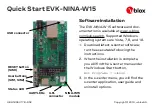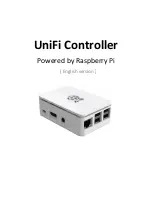
28-4
MCF5282 User’s Manual
MOTOROLA
Memory Map and Registers
28.4.2 Reset Status Register (RSR)
The RSR contains a status bit for every reset source. When reset is entered, the cause of the
reset condition is latched along with a value of 0 for the other reset sources that were not
pending at the time of the reset condition. These values are then reflected in RSR. One or
more status bits may be set at the same time. The cause of any subsequent reset is also
recorded in the register, overwriting status from the previous reset condition.
RSR can be read at any time. Writing to RSR has no effect.
4
LVDF
LVD flag. Indicates the low-voltage detect status if LVDE is set. Write a 1 to clear the LVDF bit.
1 Low voltage has been detected
0 Low voltage has not been detected
NOTE: The setting of this flag causes an LVD interrupt if LVDE and LVDIE bits are set and
LVDRE is cleared when the supply voltage V
DD
drops below V
DD
(minimum). The vector for
this interrupt is shared with INT0 of the EPORT module. Interrupt arbitration in the interrupt
service routine is necessary if both of these interrupts are enabled. Also, LVDF is not cleared
at reset, however it will always initialize to a zero since the part will not come out of reset while
in a low-power state (LVDE/LVDRE bits are enabled out of reset).
3
LVDIE
LVD interrupt enable. Controls the LVD interrupt if LVDE is set. This bit has no effect if the
LVDE bit is a logic 0.
1 LVD interrupt enabled
0 LVD interrupt disabled
2
LVDRE
LVD reset enable. Controls the LVD reset if LVDE is set. This bit has no effect if the LVDE bit
is a logic 0. LVD reset has priority over LVD interrupt, if both are enabled.
1 LVD reset enabled
0 LVD reset disabled
1
—
Reserved, should be cleared.
0
LVDE
Controls whether the LVD is enabled.
1 LVD is enabled
0 LVD is disabled
7
6
5
4
3
2
1
0
Field
—
LVD
SOFT
WDR
POR
EXT
LOC
LOL
Reset
Reset Dependent
R/W
R
Address
0x11_0001
Figure 28-3. Reset Status Register (RSR)
Table 28-3. RCR Field Descriptions (continued)
Bit(s)
Name
Description
Summary of Contents for ColdFire MCF5281
Page 124: ...3 20 MCF5282 User s Manual MOTOROLA EMAC Instruction Set Summary ...
Page 141: ...MOTOROLA Chapter 5 Static RAM SRAM 5 5 SRAM Programming Model ...
Page 142: ...5 6 MCF5282 User s Manual MOTOROLA SRAM Programming Model ...
Page 168: ...6 26 MCF5282 User s Manual MOTOROLA Interrupts ...
Page 186: ...7 18 MCF5282 User s Manual MOTOROLA Functional Description ...
Page 228: ...9 22 MCF5282 User s Manual MOTOROLA Functional Description ...
Page 246: ...10 18 MCF5282 User s Manual MOTOROLA Low Power Wakeup Operation ...
Page 254: ...11 8 MCF5282 User s Manual MOTOROLA Memory Map and Registers ...
Page 264: ...12 10 MCF5282 User s Manual MOTOROLA Chip Select Registers ...
Page 280: ...13 16 MCF5282 User s Manual MOTOROLA Misaligned Operands ...
Page 314: ...14 34 MCF5282 User s Manual MOTOROLA MCF5282 External Signals ...
Page 339: ...MOTOROLA Chapter 15 Synchronous DRAM Controller Module 15 25 SDRAM Example ...
Page 340: ...15 26 MCF5282 User s Manual MOTOROLA SDRAM Example ...
Page 356: ...16 16 MCF5282 User s Manual MOTOROLA DMA Controller Module Functional Description ...
Page 408: ...17 52 MCF5282 User s Manual MOTOROLA Buffer Descriptors ...
Page 446: ...20 24 MCF5282 User s Manual MOTOROLA Interrupts ...
Page 474: ...22 18 MCF5282 User s Manual MOTOROLA Programming Model ...
Page 510: ...23 36 MCF5282 User s Manual MOTOROLA Operation ...
Page 526: ...24 16 MCF5282 User s Manual MOTOROLA I2C Programming Examples ...
Page 672: ...28 12 MCF5282 User s Manual MOTOROLA Functional Description ...
Page 718: ...29 46 MCF5282 User s Manual MOTOROLA Motorola Recommended BDM Pinout ...
Page 750: ...32 8 MCF5282 User s Manual MOTOROLA Ordering Information ...
















































